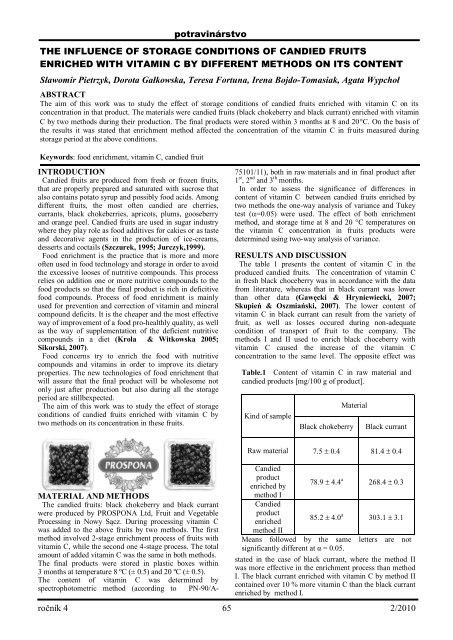Create successful ePaper yourself
Turn your PDF publications into a flip-book with our unique Google optimized e-Paper software.
potravinárstvo<br />
THE INFLUENCE OF STORAGE CONDITIONS OF CANDIED FRUITS<br />
ENRICHED WITH VITAMIN C BY DIFFERENT METHODS ON ITS CONTENT<br />
Sławomir Pietrzyk, Dorota Gałkowska, Teresa Fortuna, Irena Bojdo-Tomasiak, Agata Wypchoł<br />
ABSTRACT<br />
The aim of this work was to study the effect of storage conditions of candied fruits enriched with vitamin C on its<br />
concentration in that product. The materials were candied fruits (black chokeberry and black currant) enriched with vitamin<br />
C by two methods during their production. The final products were stored within 3 months at 8 and 20�C. On the basis of<br />
the results it was stated that enrichment method affected the concentration of the vitamin C in fruits measured during<br />
storage period at the above conditions.<br />
Keywords: food enrichment, vitamin C, candied fruit<br />
INTRODUCTION<br />
Candied fruits are produced from fresh or frozen fruits,<br />
that are properly prepared and saturated with sucrose that<br />
also contains potato syrup and possibly food acids. Among<br />
different fruits, the most often candied are cherries,<br />
currants, black chokeberries, apricots, plums, gooseberry<br />
and orange peel. Candied fruits are used in sugar industry<br />
where they play role as food additives for cakies or as taste<br />
and decorative agents in the production of ice-creams,<br />
desserts and coctails (Szczurek, 1995; Jurczyk,1999).<br />
Food enrichment is the practice that is more and more<br />
often used in food technology and storage in order to avoid<br />
the excessive looses of nutritive compounds. This process<br />
relies on addition one or more nutritive compounds to the<br />
food products so that the final product is rich in deficitive<br />
food compounds. Process of food enrichment is mainly<br />
used for prevention and correction of vitamin and mineral<br />
compound deficits. It is the cheaper and the most effective<br />
way of improvement of a food pro-healthly quality, as well<br />
as the way of supplementation of the deficient nutritive<br />
compounds in a diet (Krola & Witkowska 2005;<br />
Sikorski, 2007).<br />
Food concerns try to enrich the food with nutritive<br />
compounds and vitamins in order to improve its dietary<br />
properties. The new technologies of food enrichment that<br />
will assure that the final product will be wholesome not<br />
only just after production but also during all the storage<br />
period are stillbexpected.<br />
The aim of this work was to study the effect of storage<br />
conditions of candied fruits enriched with vitamin C by<br />
two methods on its concentration in these fruits.<br />
MATERIAL AND METHODS<br />
The candied fruits: black chokeberry and black currant<br />
were produced by PROSPONA Ltd, Fruit and Vegetable<br />
Processing in Nowy Sącz. During processing vitamin C<br />
was added to the above fruits by two methods. The first<br />
method involved 2-stage enrichment process of fruits with<br />
vitamin C, while the second one 4-stage process. The total<br />
amount of added vitamin C was the same in both methods.<br />
The final products were stored in plastic boxes within<br />
3 months at temperature 8 ºC (± 0.5) and 20 ºC (± 0.5).<br />
The content of vitamin C was determined by<br />
spectrophotometric method (according to PN-90/A-<br />
75101/11), both in raw materials and in final product after<br />
1 st , 2 nd and 3 th months.<br />
In order to assess the significance of differences in<br />
content of vitamin C between candied fruits enriched by<br />
two methods the one-way analysis of variance and Tukey<br />
test (�=0.05) were used. The effect of both enrichment<br />
method, and storage time at 8 and 20 �C temperatures on<br />
the vitamin C concentration in fruits products were<br />
determined using two-way analysis of variance.<br />
RESULTS AND DISCUSSION<br />
The table 1 presents the content of vitamin C in the<br />
produced candied fruits. The concentration of vitamin C<br />
in fresh black choceberry was in accordance with the data<br />
from literature, whereas that in black currant was lower<br />
than other data (Gawęcki & Hryniewiecki, 2007;<br />
Skupień & Oszmiański, 2007). The lower content of<br />
vitamin C in black currant can result from the variety of<br />
fruit, as well as losses occured during non-adequate<br />
condition of transport of fruit to the company. The<br />
methods I and II used to enrich black choceberry with<br />
vitamin C caused the increase of the vitamin C<br />
concentration to the same level. The opposite effect was<br />
Table.1 Content of vitamin C in raw material and<br />
candied products [mg/100 g of product].<br />
Kind of sample<br />
Material<br />
Black chokeberry Black currant<br />
Raw material 7.5 � 0.4 81.4 � 0.4<br />
Candied<br />
product<br />
enriched by<br />
method I<br />
Candied<br />
product<br />
enriched<br />
method II<br />
78.9 � 4.4 a<br />
85.2 � 4.0 a<br />
268.4 � 0.3<br />
303.1 � 3.1<br />
Means followed by the same letters are not<br />
significantly different at α = 0.05.<br />
stated in the case of black currant, where the method II<br />
was more effective in the enrichment process than method<br />
I. The black currant enriched with vitamin C by method II<br />
contained over 10 % more vitamin C than the black currant<br />
enriched by method I.<br />
ročník 4 65 2/2010






